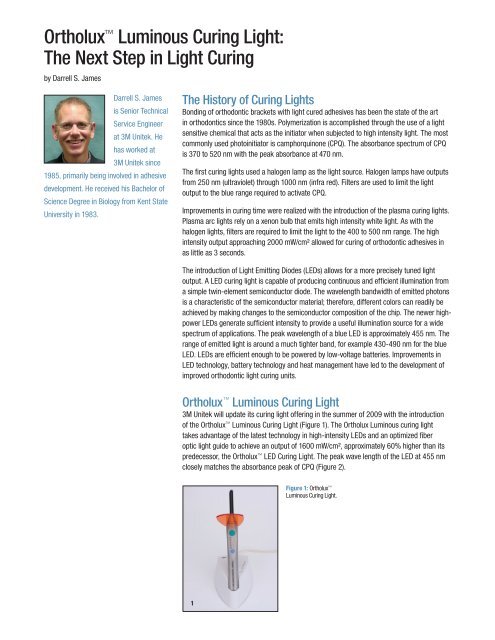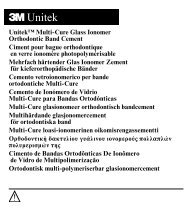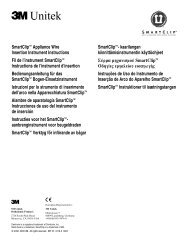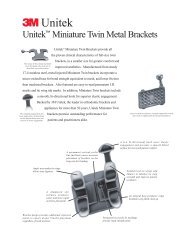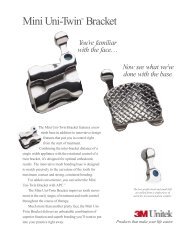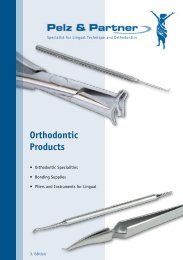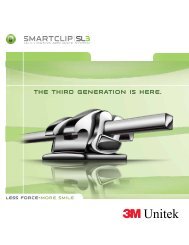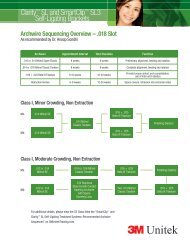Ortholux™ Luminous Curing Light: The Next Step in Light Curing - 3M
Ortholux™ Luminous Curing Light: The Next Step in Light Curing - 3M
Ortholux™ Luminous Curing Light: The Next Step in Light Curing - 3M
Create successful ePaper yourself
Turn your PDF publications into a flip-book with our unique Google optimized e-Paper software.
Ortholux <strong>Lum<strong>in</strong>ous</strong> <strong>Cur<strong>in</strong>g</strong> <strong>Light</strong>:<br />
<strong>The</strong> <strong>Next</strong> <strong>Step</strong> <strong>in</strong> <strong>Light</strong> <strong>Cur<strong>in</strong>g</strong><br />
by Darrell S. James<br />
Darrell S. James<br />
is Senior Technical<br />
Service Eng<strong>in</strong>eer<br />
at <strong>3M</strong> Unitek. He<br />
has worked at<br />
<strong>3M</strong> Unitek s<strong>in</strong>ce<br />
1985, primarily be<strong>in</strong>g <strong>in</strong>volved <strong>in</strong> adhesive<br />
development. He received his Bachelor of<br />
Science Degree <strong>in</strong> Biology from Kent State<br />
University <strong>in</strong> 1983.<br />
<strong>The</strong> History of <strong>Cur<strong>in</strong>g</strong> <strong>Light</strong>s<br />
Bond<strong>in</strong>g of orthodontic brackets with light cured adhesives has been the state of the art<br />
<strong>in</strong> orthodontics s<strong>in</strong>ce the 1980s. Polymerization is accomplished through the use of a light<br />
sensitive chemical that acts as the <strong>in</strong>itiator when subjected to high <strong>in</strong>tensity light. <strong>The</strong> most<br />
commonly used photo<strong>in</strong>itiator is camphorqu<strong>in</strong>one (CPQ). <strong>The</strong> absorbance spectrum of CPQ<br />
is 370 to 520 nm with the peak absorbance at 470 nm.<br />
<strong>The</strong> first cur<strong>in</strong>g lights used a halogen lamp as the light source. Halogen lamps have outputs<br />
from 250 nm (ultraviolet) through 1000 nm (<strong>in</strong>fra red). Filters are used to limit the light<br />
output to the blue range required to activate CPQ.<br />
Improvements <strong>in</strong> cur<strong>in</strong>g time were realized with the <strong>in</strong>troduction of the plasma cur<strong>in</strong>g lights.<br />
Plasma arc lights rely on a xenon bulb that emits high <strong>in</strong>tensity white light. As with the<br />
halogen lights, filters are required to limit the light to the 400 to 500 nm range. <strong>The</strong> high<br />
<strong>in</strong>tensity output approach<strong>in</strong>g 2000 mW/cm² allowed for cur<strong>in</strong>g of orthodontic adhesives <strong>in</strong><br />
as little as 3 seconds.<br />
<strong>The</strong> <strong>in</strong>troduction of <strong>Light</strong> Emitt<strong>in</strong>g Diodes (LEDs) allows for a more precisely tuned light<br />
output. A LED cur<strong>in</strong>g light is capable of produc<strong>in</strong>g cont<strong>in</strong>uous and efficient illum<strong>in</strong>ation from<br />
a simple tw<strong>in</strong>-element semiconductor diode. <strong>The</strong> wavelength bandwidth of emitted photons<br />
is a characteristic of the semiconductor material; therefore, different colors can readily be<br />
achieved by mak<strong>in</strong>g changes to the semiconductor composition of the chip. <strong>The</strong> newer highpower<br />
LEDs generate sufficient <strong>in</strong>tensity to provide a useful illum<strong>in</strong>ation source for a wide<br />
spectrum of applications. <strong>The</strong> peak wavelength of a blue LED is approximately 455 nm. <strong>The</strong><br />
range of emitted light is around a much tighter band, for example 430-490 nm for the blue<br />
LED. LEDs are efficient enough to be powered by low-voltage batteries. Improvements <strong>in</strong><br />
LED technology, battery technology and heat management have led to the development of<br />
improved orthodontic light cur<strong>in</strong>g units.<br />
Ortholux <strong>Lum<strong>in</strong>ous</strong> <strong>Cur<strong>in</strong>g</strong> <strong>Light</strong><br />
<strong>3M</strong> Unitek will update its cur<strong>in</strong>g light offer<strong>in</strong>g <strong>in</strong> the summer of 2009 with the <strong>in</strong>troduction<br />
of the Ortholux <strong>Lum<strong>in</strong>ous</strong> <strong>Cur<strong>in</strong>g</strong> <strong>Light</strong> (Figure 1). <strong>The</strong> Ortholux <strong>Lum<strong>in</strong>ous</strong> cur<strong>in</strong>g light<br />
takes advantage of the latest technology <strong>in</strong> high-<strong>in</strong>tensity LEDs and an optimized fiber<br />
optic light guide to achieve an output of 1600 mW/cm², approximately 60% higher than its<br />
predecessor, the Ortholux LED <strong>Cur<strong>in</strong>g</strong> <strong>Light</strong>. <strong>The</strong> peak wave length of the LED at 455 nm<br />
closely matches the absorbance peak of CPQ (Figure 2).<br />
1<br />
Figure 1: Ortholux <br />
<strong>Lum<strong>in</strong>ous</strong> <strong>Cur<strong>in</strong>g</strong> <strong>Light</strong>.
2<br />
Figure 2: Spectrum Overlap.<br />
<strong>The</strong> Ortholux <strong>Lum<strong>in</strong>ous</strong> <strong>Cur<strong>in</strong>g</strong> <strong>Light</strong> is equipped with the latest,<br />
high performance, LEDs available. Excess heat is managed by<br />
mount<strong>in</strong>g the LED on a heat s<strong>in</strong>k. <strong>The</strong> heat s<strong>in</strong>k allows for a fanless<br />
design which results <strong>in</strong> quiet operation.<br />
<strong>The</strong> Ortholux <strong>Lum<strong>in</strong>ous</strong> cur<strong>in</strong>g light is powered by a Lithium ion<br />
battery. Lithium ion batteries can store 1.5 to 2 times the power of<br />
a nickel metal hydride battery. <strong>The</strong>y do not have to be conditioned<br />
with three charge/discharge cycles, hold their charge better and<br />
have no memory effect, mean<strong>in</strong>g that the batteries do not have to<br />
be completely discharged between recharge cycles. Additionally,<br />
Lithium ion batteries are classified by the federal government<br />
as non-hazardous waste and are safe for disposal <strong>in</strong> the normal<br />
municipal waste stream. <strong>The</strong> batteries should be disposed of<br />
accord<strong>in</strong>g to the applicable state and local regulations.<br />
In addition to the high <strong>in</strong>tensity LED, the black-coated, 8 mm light<br />
guide contributes to the 1600 mW/cm² output of the Ortholux<br />
<strong>Lum<strong>in</strong>ous</strong> cur<strong>in</strong>g light (Figure 3). <strong>The</strong> light guide diameter is<br />
3 4<br />
Figure 3: 8 mm light guide on the<br />
Ortholux <strong>Lum<strong>in</strong>ous</strong> <strong>Cur<strong>in</strong>g</strong> <strong>Light</strong>.<br />
Figure 4: <strong>The</strong> Ortholux <strong>Lum<strong>in</strong>ous</strong><br />
<strong>Cur<strong>in</strong>g</strong> <strong>Light</strong> has larger activation buttons.<br />
designed to provide a high <strong>in</strong>tensity output and to optimize the<br />
orthodontic cur<strong>in</strong>g pattern for the recommended mesial and distal<br />
cur<strong>in</strong>g technique or the alterative <strong>in</strong>terproximal cur<strong>in</strong>g technique.<br />
<strong>The</strong> black coat<strong>in</strong>g of the light guide assures the user that the<br />
high <strong>in</strong>tensity light is be<strong>in</strong>g directed <strong>in</strong>to the oral cavity and not<br />
extraneously throughout the operatory. In addition, the light guide<br />
utilizes a magnetic mount<strong>in</strong>g feature which facilitates easy rotation<br />
of the light guide <strong>in</strong>dependent of the eye shield. <strong>The</strong> improved eye<br />
shield serves as a table rest for the light and prevents the light from<br />
roll<strong>in</strong>g off a surface when not seated <strong>in</strong> the charg<strong>in</strong>g base.<br />
<strong>The</strong> on/off and activation buttons of the Ortholux <strong>Lum<strong>in</strong>ous</strong> cur<strong>in</strong>g<br />
light have been improved by mak<strong>in</strong>g them larger and more tactile<br />
than those of other lights (Figure 4). <strong>The</strong> s<strong>in</strong>gle piece sta<strong>in</strong>less<br />
steel hous<strong>in</strong>g makes the unit more resistant to breakage and easy<br />
to dis<strong>in</strong>fect. <strong>The</strong> raised buttons, smooth hous<strong>in</strong>g and pen-shaped<br />
design contribute to the ergonomic feel of the light. <strong>The</strong> charg<strong>in</strong>g<br />
base <strong>in</strong>cludes an <strong>in</strong>tegrated light <strong>in</strong>tensity meter with values from<br />
60% to 100% <strong>in</strong>tensity. <strong>The</strong> light <strong>in</strong>tensity is not a function of<br />
battery charge level or battery life.<br />
<strong>The</strong> Ortholux <strong>Lum<strong>in</strong>ous</strong> cur<strong>in</strong>g light <strong>in</strong>cludes time sett<strong>in</strong>gs of 3,<br />
6, 9 and 12 seconds. <strong>The</strong>se sett<strong>in</strong>gs are applicable to cur<strong>in</strong>g all<br />
orthodontic appliances, <strong>in</strong>clud<strong>in</strong>g ceramic brackets, metal brackets,<br />
5<br />
Figure 5: Bond Strength Development: Victory Series U Central Brackets with<br />
Transbond XT Adhesive.<br />
6<br />
Figure 6: Bond Strength Development: Clarity U Central Brackets with<br />
Transbond XT Adhesive.
uccal tubes, bands and l<strong>in</strong>gual reta<strong>in</strong>ers. <strong>The</strong> light also <strong>in</strong>cludes a<br />
convenient 1-second tack cure function. <strong>The</strong> tack cure function is<br />
a feature that many customers requested. <strong>The</strong> one second burst of<br />
light allows the cl<strong>in</strong>ician to get an <strong>in</strong>itial cure before mov<strong>in</strong>g on to<br />
place other brackets. This may be particularly useful <strong>in</strong> seal<strong>in</strong>g the<br />
g<strong>in</strong>gival seam on patients where moisture control is an issue.<br />
Bond strength achieved with the Ortholux <strong>Lum<strong>in</strong>ous</strong> <strong>Cur<strong>in</strong>g</strong> <strong>Light</strong><br />
at three seconds is equivalent to the Ortholux LED <strong>Cur<strong>in</strong>g</strong> <strong>Light</strong> at<br />
five seconds. Mesh based Victory Series Upper Central Brackets<br />
or ceramic Clarity Metal Re<strong>in</strong>forced Upper Central Ceramic<br />
Brackets were bonded to bov<strong>in</strong>e teeth with Transbond XT <strong>Light</strong><br />
Cure Adhesive. Bond strength was tested five m<strong>in</strong>utes after cur<strong>in</strong>g<br />
and 24 hours after cur<strong>in</strong>g. <strong>The</strong> bond strengths are similar at each<br />
test <strong>in</strong>terval (Figure 5 and 6).<br />
Customer acceptance evaluations conducted with orthodontists <strong>in</strong> the<br />
US, show a 94% satisfaction with the performance of the Ortholux<br />
<strong>Lum<strong>in</strong>ous</strong> cur<strong>in</strong>g light and 88% satisfactions with the features of the<br />
light. <strong>The</strong> most often mentioned improvement was the time sav<strong>in</strong>gs<br />
from the 3-second cur<strong>in</strong>g time. Evaluators were also impressed with<br />
the larger raised TIME and START buttons and the ease of clean<strong>in</strong>g<br />
and dis<strong>in</strong>fect<strong>in</strong>g the sta<strong>in</strong>less steel handpiece and light guide.<br />
<strong>The</strong> improvements offered by the Ortholux <strong>Lum<strong>in</strong>ous</strong> cur<strong>in</strong>g light<br />
will benefit the orthodontist <strong>in</strong> several ways. <strong>The</strong> high <strong>in</strong>tensity light<br />
Overall Satisfaction -<br />
Features<br />
Overall Satisfaction -<br />
Performance<br />
7<br />
0%<br />
Figure 7: Customer Acceptance Evaluation.<br />
Strongly Agree Agree Neutral Disagree Strongly Disagree<br />
10% 20% 30% 40% 50% 60% 70% 80% 90% 100%<br />
will reduce the time required to cure brackets, thus reduc<strong>in</strong>g the<br />
chair time for the patient and the time required of the orthodontist<br />
or assistant. <strong>The</strong> ergonomic shape and improve tactile feel of the<br />
buttons will be appreciated by the user as well. Dis<strong>in</strong>fections and<br />
clean<strong>in</strong>g are improved via the one-piece sta<strong>in</strong>less steel hous<strong>in</strong>g.<br />
<strong>The</strong> Ortholux <strong>Lum<strong>in</strong>ous</strong> cur<strong>in</strong>g light is lightweight, portable and<br />
quiet. <strong>The</strong> Lithium ion battery overcomes many of the issues with<br />
the older Nickel metal hydride batteries. All-<strong>in</strong>-all, the Ortholux<br />
<strong>Lum<strong>in</strong>ous</strong> cur<strong>in</strong>g light is a step <strong>in</strong> the right direction; efficiency, ease<br />
of use, and ease of care, for cur<strong>in</strong>g of orthodontic appliances <strong>in</strong> the<br />
busy orthodontic practices of the 21st century.<br />
Repr<strong>in</strong>ted from Orthodontic Perspectives Vol. XVI No. 1.<br />
© 2009 <strong>3M</strong>. All rights reserved.


